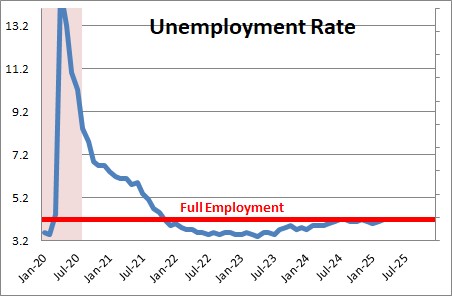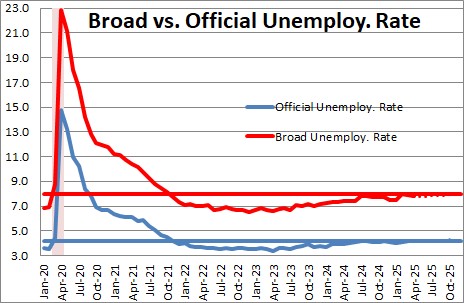May 2, 2025

The unemployment rate was unchanged in April at 4.2% after having risen 0.1% in March. The labor force rose by 518 thousand in April while employment rose by 436 thousand. As a result, the number of unemployed workers rose 82 thousand and the unemployment rate was unchanged at 4.2%.. But payroll employment rose by 177 thousand in April versus the 436 thousand increase in civilian employment.
How come the two estimates of employment are different? First, the two are figures are derived from separate data streams. The payroll number is calculated from employment numbers reported by a large number of employers across all industries. Employment for the unemployment rate calculation is derived from knocking on doors and asking people if they have a job. It is known as the household survey. It tends to be more volatile than the payroll employment data. One conceptual difference is that the household survey includes people who are self-employed which would not be captured in the establishment survey. In the end, there is always monthly noise between the two series. Over time the two surveys seem to show roughly comparable gains in employment.
The Fed considers full employment to be 4.2% so its current level of 4.2% should be relatively comforting. The number of jobs being created (as measured by the change in payroll employment) is acceptable, While firms appear to be concerned about slower economic growth in the months ahead, it is hard to discern much change in the labor market.
While the official rate is the most widely used, the reality is that the official rate can be misleading because it does not include “underemployed” workers. There are two types of “underemployed” workers. First, there are people who have unsuccessfully sought employment for so long that they have given up looking for a job (discouraged workers). Second, are those workers that currently have a part time position but indicate that they would like full time employment. The total of these two types of underemployed workers are “marginally attached” to the labor force. The number of these workers risen slightly in recent months to 1,616 thousand.
 .
.
To incorporate the impact of these marginally employed workers we should probably focus on a broader measure of unemployment which declined 0.1% in April to 7.8% after having fallen 0.1% in March. Full employment for this measure of unemployment is somewhere round the 8.0% mark.

Stephen Slifer
NumberNomics
Charleston, SC

Follow Me